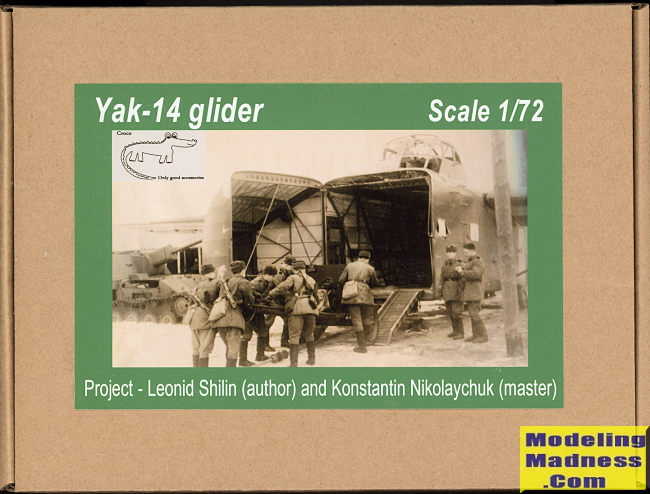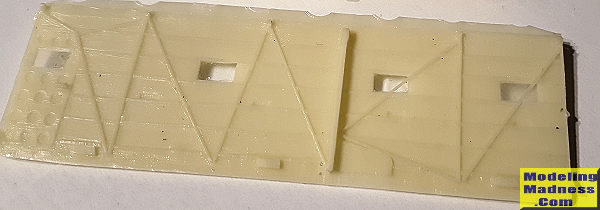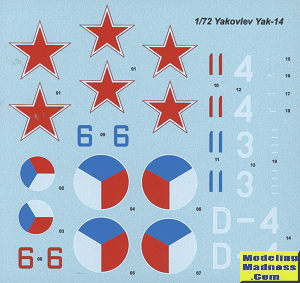
Croco 1/72 Yak-14
| KIT #: | |
| PRICE: | $ |
| DECALS: | Six options |
| REVIEWER: | Scott Van Aken |
| NOTES: | Resin kit with vacuformed clear parts. |

| HISTORY |
Yakovlev's design, the Yak-14 was a high-wing monoplane. It had a rectangular section fuselage with a steel-tube and dural structure with a fabric covering. To aid loading and unloading of cargo, the aircraft's nose swung to the right with the tail section pivoting to the left. The two pilots sat side by side in an enclosed cockpit above the left side of the fuselage. They were provided with a display that used a transmitter in the towing aircraft to show the relative positions of the two aircraft when flying in cloud. The wings were made of dural and fabric and were braced to the fuselage by a single strut on each side. Large slotted trailing-edge flaps were fitted to the wings, while the aircraft was fitted with a fixed nosewheel undercarriage which could be made to "kneel" by releasing air from the pneumatic shock struts of the undercarriage, lowering the fuselage for ease of unloading or to make short landings on belly-mounted skids.
The first prototype made its maiden flight in June 1948 from Medvyezhe Ozero, near Omsk. Official testing resulted in a number of changes to the design, with a large dorsal fin being fitted, and spoilers being added to reduce landing runs, while the payload of the glider was increased to allow an ASU-57 assault gun to be carried. As such the Yak-14 passed its acceptance trials from August to September 1949, with the glider entering mass production later that year.
While some Yak-14s were constructed at Chkalovsk, the majority were produced at Rostov-on-Don. Total production was 413 series gliders.
The Yak-14 filled an important role in Soviet service in the 1950s, being the only way of carrying large loads by air to remote parts of the Soviet Union without having to disassemble the loads. The usual tug was the Ilyushin Il-12.
One Yak-14 was flown to the North Pole in 1950, while another example of the glider's versatility took place in March 1954, when four Yak-14s made a long-distance flight to an ice station on an ice floe drifting on the Arctic Ocean, with the supplies delivered including a large bulldozer. The gliders flew from Tula on March 10, with several stops at Omsk, Krasnoyarsk and the Schmidt Cape, on Sakhalin island in the Far East, before reaching SP-4 in early April during a heavy freeze.
A few were delivered to Czechoslovakia in the early 1950s which used them under the designation NK-14.
Soviet Air Force transport gliders were gradually withdrawn from service with the arrival of turboprop transports like the Antonov An-24 and Antonov An-12, which entered service in the late 1950s.
| THE KIT |
 It takes
companies such as Croco to produce kits like this. The only other Yak-14 of
which I'm aware is one that is also in resin and in 1/144 scale. This kit was in
development for some time and that is due to the amount of detail provided for
the interior as much as anything else. Overall detailing really is superb and
I've provided photos to show what I mean. One is the interior wall of the main
fuselage piece and the other is the rivet detail of the metal leading edge of
the wing.
It takes
companies such as Croco to produce kits like this. The only other Yak-14 of
which I'm aware is one that is also in resin and in 1/144 scale. This kit was in
development for some time and that is due to the amount of detail provided for
the interior as much as anything else. Overall detailing really is superb and
I've provided photos to show what I mean. One is the interior wall of the main
fuselage piece and the other is the rivet detail of the metal leading edge of
the wing.
 Since the
nose and tail section can be modeled open, the kit's fuselage is basically in
three parts. The wing is in four with the center section being incorporated into
the fuselage assembly. A shorter piece attaches to that and that is also where
the struts are attached. Finally the outer section is glued in place. The wing,
tail, and horizontal stabs are all single castings. These have pins which fit
into various slots. One may wish to drill out the outer and inner wings for a
spar if one things it is needed. I've never had issues with this sort of
assembly, but some may prefer to do so.
Since the
nose and tail section can be modeled open, the kit's fuselage is basically in
three parts. The wing is in four with the center section being incorporated into
the fuselage assembly. A shorter piece attaches to that and that is also where
the struts are attached. Finally the outer section is glued in place. The wing,
tail, and horizontal stabs are all single castings. These have pins which fit
into various slots. One may wish to drill out the outer and inner wings for a
spar if one things it is needed. I've never had issues with this sort of
assembly, but some may prefer to do so.
I would guess that the majority of the parts are used in the interior. This includes various braces for the overhead and bulkheads. All of these parts are very nicely molded and those that may be prone to breaking in shipping are in a pack that is reinforced with cardboard. One feature of this kit, which I think is smart, is to provide a bending template for the various hand holds and the troop seat frames. Croco recommends 0.2mm copper wire for this, but you can substitute whatever is equivalent in other wire materials. 0.2mm is about .008 inches and this wire is fairly common.
 The upper
deck cockpit section is such that it can be added last. It consists of a couple
of seats, rudder pedals, control columns and instrument panel. A radio suite is
also provided. This is covered by a vacuformed canopy section of which two are
provided. The cabin windows are also vac plastic. As another option, you can
model the aircraft in the lowered position with a bit of adjustment to the kit
bits. Two different length loading ramps are provided.
The upper
deck cockpit section is such that it can be added last. It consists of a couple
of seats, rudder pedals, control columns and instrument panel. A radio suite is
also provided. This is covered by a vacuformed canopy section of which two are
provided. The cabin windows are also vac plastic. As another option, you can
model the aircraft in the lowered position with a bit of adjustment to the kit
bits. Two different length loading ramps are provided.
Instructions are well drawn and provide detail information when required. Typical of Croco instructions for aircraft, the parts are numbered, but there is no overall parts diagram. Not really an issue for the level of modeler who will be building this. A very nicely done decal sheet is provided giving markings for several Soviet and one Czech aircraft. Check the Internet for photos and possible camouflage schemes as there are images there to help in this regard. Most were an overall dark green or had a light blue underside.
| CONCLUSIONS |
This is a very nice kit and one that is welcome for those who like things a bit different. Croco has provided a lot of nicely done detail for this and those who really like to detail kits will be quite pleased with this one. Those who are a bit on the lazy side can build it closed up, thereby passing all that nice interior detailing. Either way it is a kit that will make into a nice, and somewhat unusual model.
| REFERENCES |
https://en.wikipedia.org/wiki/Yakovlev_Yak-14
October 2019
Copyright Modeling Madness.com. All rights reserved.
Thanks to Croco for the preview kit. These kits can be
found by a Google or an e-mail to
sniff23@inbox.lv.
If you would like your product reviewed fairly and fairly quickly, please
contact
the editor
or see other details in the
Note to
Contributors.
Back to the Main Page
Back to the Review
Index Page
Back to the Previews Index Page